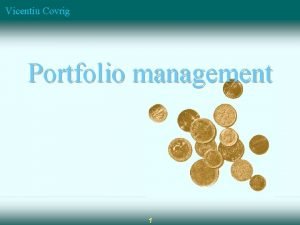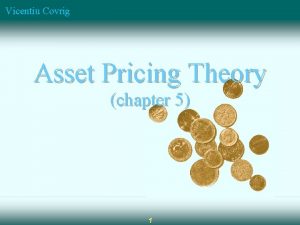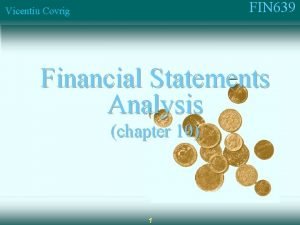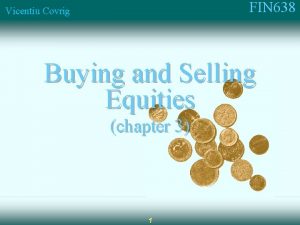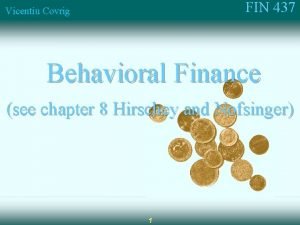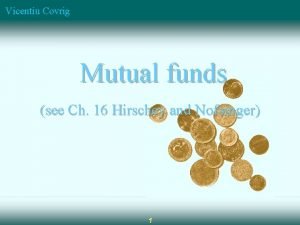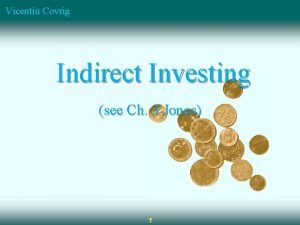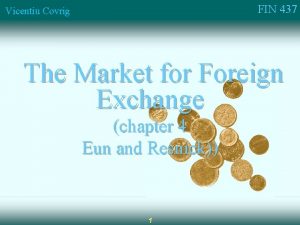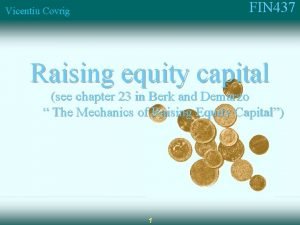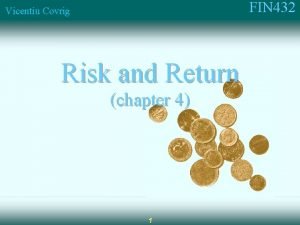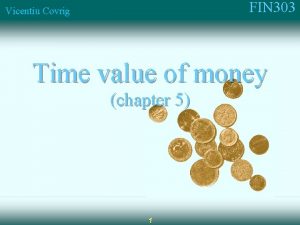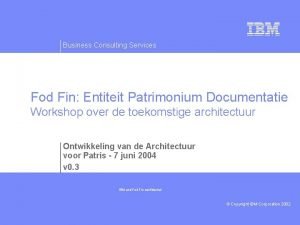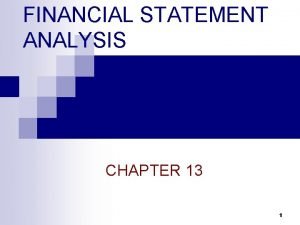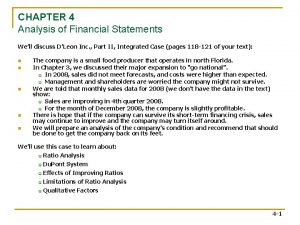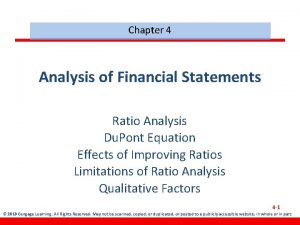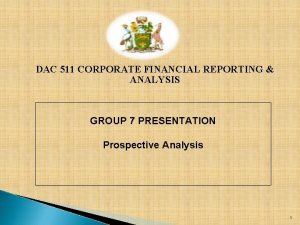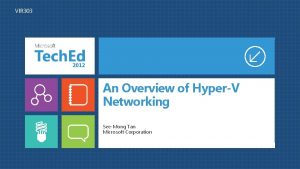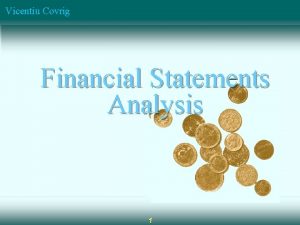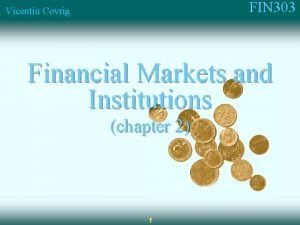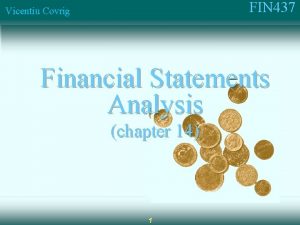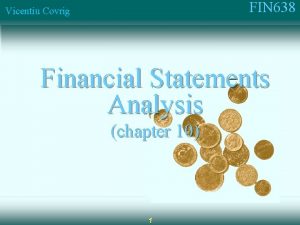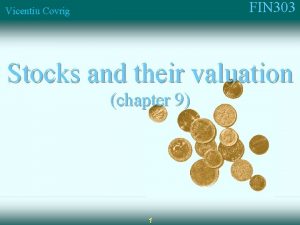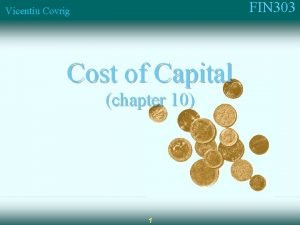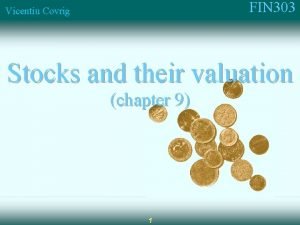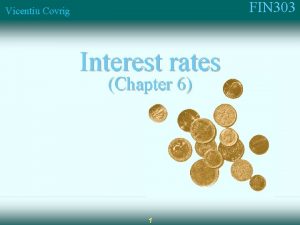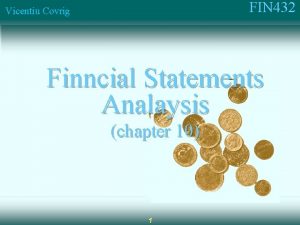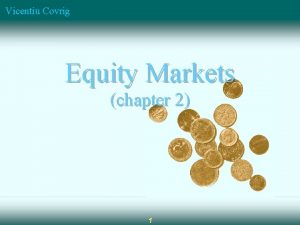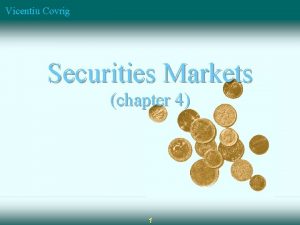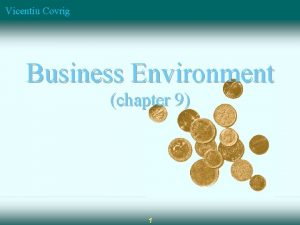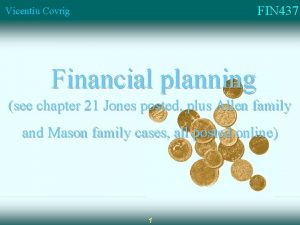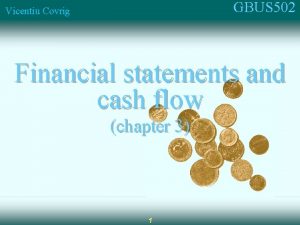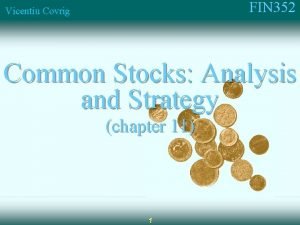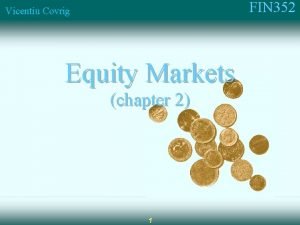FIN 303 Vicentiu Covrig Analysis of financial statements

























- Slides: 25

FIN 303 Vicentiu Covrig Analysis of financial statements (chapter 4) 1

FIN 303 Vicentiu Covrig Ratio analysis: Why are ratios useful? n Ratios standardize numbers and facilitate comparisons n Ratios are used to highlight weaknesses and strengths. n Ratio comparisons should be made through time and with competitors - Trend analysis - Peer (or Industry) analysis 2

FIN 303 Vicentiu Covrig What are the five major categories of ratios, and what questions do they answer? n n n Liquidity: Can we make required payments? Asset management: right amount of assets vs. sales? Debt management: Right mix of debt and equity? Profitability: Do sales prices exceed unit costs, and are sales high enough as reflected in PM, ROE, and ROA? Market value: Do investors like what they see as reflected in P/E and M/B ratios? 3

FIN 303 Vicentiu Covrig D’Leon’s Balance Sheet: Assets Cash A/R Inventories Total CA Gross FA Less: Dep. Net FA Total Assets 2003 E 85, 632 878, 000 1, 716, 480 2, 680, 112 1, 197, 160 380, 120 817, 040 3, 497, 152 4 2002 7, 282 632, 160 1, 287, 360 1, 926, 802 1, 202, 950 263, 160 939, 790 2, 866, 592

FIN 303 Vicentiu Covrig D’Leon’s Balance sheet: Liabilities and Equity Accts payable Notes payable Accruals Total CL Long-term debt Common stock Retained earnings Total Equity Total L & E 2003 E 436, 800 300, 000 408, 000 1, 144, 800 400, 000 1, 721, 176 231, 176 1, 952, 352 3, 497, 152 5 2002 524, 160 636, 808 489, 600 1, 650, 568 723, 432 460, 000 32, 592 492, 592 2, 866, 592

FIN 303 Vicentiu Covrig D’Leon’s Income statement Sales COGS Other expenses EBITDA Depr. & Amort. EBIT Interest Exp. EBT Taxes Net income 2003 E 7, 035, 600 5, 875, 992 550, 000 609, 608 116, 960 492, 648 70, 008 422, 640 169, 056 253, 584 6 2002 6, 034, 000 5, 528, 000 519, 988 (13, 988) 116, 960 (130, 948) 136, 012 (266, 960) (106, 784) (160, 176)

FIN 303 Vicentiu Covrig Other data No. of shares EPS DPS Stock price Lease pmts 2003 E 250, 000 $1. 014 $0. 220 $12. 17 $40, 000 7 2002 100, 000 -$1. 602 $0. 110 $2. 25 $40, 000

FIN 303 Vicentiu Covrig Calculate D’Leon’s forecasted current ratio for 2003. Current ratio n n = Current assets / Current liabilities = 2003 2002 2001 Ind. 2. 34 x 1. 20 x 2. 30 x 2. 70 x Expected to improve but still below the industry average. Liquidity position is weak. 8

FIN 303 What is the inventory turnover vs. the industry average? Vicentiu Covrig Inv. turnover = Sales / Inventories = Inventory Turnover 2003 2002 2001 Ind. 4. 1 x 4. 70 x 4. 8 x 6. 1 x Inventory turnover is below industry average. D’Leon might have old inventory, or its control might be poor. 9

FIN 303 Vicentiu Covrig DSO is the average number of days after making a sale before receiving cash. DSO( days sales outstanding) = Receivables / Average sales per day = Receivables / Sales/365 = DSO 2003 2002 2001 Ind. 45. 6 38. 2 37. 4 32. 0 D’Leon collects on sales too slowly, and is getting worse. D’Leon has a poor credit policy. 10

FIN 303 Vicentiu Covrig Fixed asset and total asset turnover ratios vs. the industry average FA turnover = Sales / Net fixed assets = TA turnover = Sales / Total assets = FA TO TA TO 2003 8. 6 x 2. 0 x 2002 6. 4 x 2. 1 x 2001 10. 0 x 2. 3 x TA turnover below the industry average. Caused by excessive currents assets (A/R and Inv). 11 Ind. 7. 0 x 2. 6 x

FIN 303 Vicentiu Covrig Calculate the debt ratio and TIE Debt ratio = Total debt / Total assets = TIE (times-interest-earned) = EBIT / Interest expense = 2003 2002 2001 Ind. D/A 44. 2% 82. 8% 54. 8% 50. 0% TIE 7. 0 x -1. 0 x 4. 3 x 6. 2 x 12

FIN 303 Vicentiu Covrig Exam type question As a short-term creditor concerned with a company’s ability to meet its financial obligation to you, which one of the following combinations of ratios would you most likely prefer? Current Debt ratio TIE ratio a. 0. 5 0. 33 b. 1. 0 0. 50 c. 1. 5 0. 50 * d. 2. 0 1. 0 0. 67 13

FIN 303 Vicentiu Covrig Profitability ratios: Profit margin (net) = Net income / Sales = PM 2003 3. 6% 2002 -2. 7% 2001 2. 6% Ind. 3. 5% Profit margin was very bad in 2002, but is projected to exceed the industry average in 2003. 14

FIN 303 Vicentiu Covrig Profitability ratios: Return on assets and Return on equity ROA = Net income / Total assets = ROE = Net income / Total common equity = ROA ROE n n 2003 2002 2001 7. 3% -5. 6% 6. 0% 13. 0% -32. 5% 13. 3% Ind. 9. 1% 18. 2% Both ratios rebounded from the previous year, but are still below the industry average. More improvement is needed. Wide variations in ROE illustrate the effect that leverage can have on profitability. 15

FIN 303 Vicentiu Covrig Effects of debt on ROA and ROE n ROA is lowered by debt--interest lowers NI, which also lowers ROA = NI/Assets. n But use of debt also lowers equity, hence debt could raise ROE = NI/Equity. 16

FIN 303 Vicentiu Covrig Problems with ROE n n ROE and shareholder wealth are correlated, but problems can arise when ROE is the sole measure of performance. - ROE does not consider risk. - ROE does not consider the amount of capital invested. - Might encourage managers to make investment decisions that do not benefit shareholders. ROE focuses only on return. A better measure is one that considers both risk and return. 17

FIN 303 Vicentiu Covrig Exam type question The Wilson Corporation has the following relationships: Sales/Total assets 2. 0 Return on assets (ROA) 4. 0% Return on equity (ROE) 6. 0% What is Wilson’s profit margin and debt ratio? a. 2%; 0. 33 * b. 4%; 0. 33 c. 4%; 0. 67 d. 2%; 0. 67 18

FIN 303 Vicentiu Covrig Calculate the Price/Earnings, Price/Cash flow, and Market/Book ratios. P/E = Price / Earnings per share = M/B = Share price / Book value per share = $12. 17/(1, 952, 352/250, 000) Book value = total equity from balance sheet 2003 2002 2001 Ind. P/E 12. 0 x -1. 4 x 9. 7 x 14. 2 x M/B 1. 56 x 0. 5 x 1. 3 x 2. 4 x P/E: How much investors are willing to pay for $1 of earnings. M/B: How much investors are willing to pay for $1 of book value equity. For each ratio, the higher the number, the better. 19

FIN 303 Vicentiu Covrig Extended Du. Pont equation: Breaking down Return on equity ROE = (Profit margin) x (TA turnover) x (Equity multiplier) = 3. 6% x 2 x 1. 8 = 13. 0% Equity multiplier = total assets/total equity 2001 2002 2003 E Ind. PM 2. 6% -2. 7% 3. 6% 3. 5% TA TO 2. 3 2. 1 2. 0 2. 6 20 EM 2. 2 5. 8 1. 8 2. 0 ROE 13. 3% -32. 5% 13. 0% 18. 2%

FIN 303 Vicentiu Covrig The Du Pont system Also can be expressed as: ROE = (NI/Sales) x (Sales/TA) x (TA/Equity) n Focuses on: - Expense control (PM) - Asset utilization (TATO) - Debt utilization (Eq. Mult. ) n Shows how these factors combine to determine ROE. 21

FIN 303 Vicentiu Covrig Exam type questions A firm that has an equity multiplier of 4. 0 will have a debt ratio of a. 4. 00 b. 3. 00 c. 1. 00 d. 0. 75 * 22

FIN 303 Vicentiu Covrig Exam type question The Merriam Company has determined that its return on equity is 15 percent. Management is interested in the various components that went into this calculation. You are given the following information: total debt/total assets = 0. 35 and total assets turnover = 2. 8. What is the profit margin? a. 3. 48% * b. 5. 42% c. 6. 96% d. 2. 45% 23

FIN 303 Vicentiu Covrig Potential problems and limitations of financial ratio analysis n n n n Comparison with industry averages is difficult for a conglomerate firm that operates in many different divisions. “Average” performance is not necessarily good, perhaps the firm should aim higher. Seasonal factors can distort ratios. “Window dressing” techniques can make statements and ratios look better. Different operating and accounting practices can distort comparisons. Sometimes it is hard to tell if a ratio is “good” or “bad”. Difficult to tell whether a company is, on balance, in strong or weak position. 24

FIN 303 Vicentiu Covrig Learning objectives n n n Given all the information needed, know how to calculate and interpret all the financial ratios that are discussed in the notes, including Du. Pont analysis. For the exam, you need to know ONLY the ratios that are in these notes. Discuss potential problems and limitations of financial ratio analysis, including problems with ROE See also end of chapter problems 4 -1 to 4 -7, 4 -9 to 4 -14, 4 -17 25
 Vicentiu covrig
Vicentiu covrig Vicentiu covrig
Vicentiu covrig Vicentiu covrig
Vicentiu covrig Covrig,vicentiu m
Covrig,vicentiu m Vicentiu covrig
Vicentiu covrig Vicentiu covrig
Vicentiu covrig Vicentiu covrig
Vicentiu covrig Vicentiu covrig
Vicentiu covrig Vicentiu covrig
Vicentiu covrig Vicentiu covrig
Vicentiu covrig Vicentiu covrig
Vicentiu covrig Vicentiu covrig
Vicentiu covrig Vicentiu covrig
Vicentiu covrig Vicentiu covrig
Vicentiu covrig Spf fin fod fin
Spf fin fod fin Prisme droit à base trapèze
Prisme droit à base trapèze Analysis of financial statements
Analysis of financial statements Chapter 03 financial analysis
Chapter 03 financial analysis Chapter 4 analysis of financial statements
Chapter 4 analysis of financial statements Chapter 4 analysis of financial statements
Chapter 4 analysis of financial statements How to improve current ratio
How to improve current ratio Prospective analysis financial statements
Prospective analysis financial statements Banks income statement analysis
Banks income statement analysis 38cfr3.303
38cfr3.303 Vir 303
Vir 303 Comp 303
Comp 303

